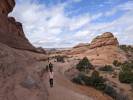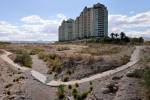Old Mormon Fort accessible way to learn valley’s history
The Old Las Vegas Mormon Fort State Historic Park, in downtown Las Vegas on Washington Avenue just off Las Vegas Boulevard, preserves remnants of the first permanent non-native settlement in Southern Nevada. Open all year from 8 a.m. to 4:30 p.m. Tuesdays through Saturdays, the park offers glimpses of history in its exhibits and interpretation of events through its programs. It includes a handsome visitor center, a reconstruction of the early fort, a re-created portion of flowing creek, a pioneer garden and part of an original wall built 156 years ago. The entrance fee is just $1 for visitors aged 13 and older.
On a particularly hot June afternoon in 1855, 15 dusty men halted their weary teams of oxen at the water of Las Vegas Creek. Lead by William Bringhurst, they had been on the 52-mile trail from the Muddy River across the Mojave Desert since the day before, June 13, traveling all night following a waterless trail marked by bones of animals that perished on previous treks.
Swiftly unloading, about half of the men filled containers with water and headed back along the trail to assist weaker teams that followed a day behind them. Finally, on June 15, all 30 Mormon missionaries sent to establish a settlement in the Las Vegas Valley assembled to give thanks and pray for their future. The event marked the beginning of the city of Las Vegas.
The purposes of the Las Vegas Mission outlined by Mormon leader Brigham Young was to establish a way station along part of the Old Spanish Trail known as the Mormon Road between Utah and Southern California and to proselytize among the native Paiute people of the area. The Mormons also routinely scouted areas they colonized for minerals, which would lead to mining on Mount Potosi southwest of the fort.
The spot chosen for the settlement lay about three miles from the main Las Vegas Spring near a slope where increased water flow in the creek would power a small mill. The men wasted no time in starting construction of a fort of adobe bricks made on site. The 14-foot walls atop foundations of stone stretched 150 feet on each side with bastions at two corners, which commanded a field of fire along the walls in case of hostilities. The eastern wall served as the back of two-story habitations and communal cooking and eating areas.
The missionaries made friendly contact with the Paiutes living in various camps in the region. Soon families joined the men, and a school for children of settlers and natives was organized.
Each man was assigned a garden plot irrigated by water diverted from the creek. They also planted orchard trees. The Paiutes often helped in the fields. By late summer, corn and other plants seemed to thrive. However, the early farmers encountered a problem Southern Nevada gardeners still find. The alkali in the soil stunted the crops, and the autumn harvest was meager. The problem was worse in the second year. A drier than normal season affected the native vegetation gathered by the Paiutes, who attempted to add to their food stores by raiding the Mormons' fields at night. Relations between the settlers and the natives began to sour.
Crop failures, difficulties in lead mining, overwork, summer temperatures, internal squabbles and the threat of war in Utah contributed to the abandonment of the settlement in 1857. A decade later, the fort was manned by soldiers for a time. Ranchers and other owners that followed used the remnants of the fort and the irrigation channels the Mormons left. The unprotected walls melted away except for one portion preserved as a wall in a small building utilized for the testing of concrete during the construction of Hoover Dam.
Programs and events scheduled at the Old Las Vegas Mormon Fort throughout the year bring historic times to life. Learn more about the soldiers of the fort during re-enactments Saturday and about Civil War-living during family activities on May 28. On June 11, enjoy breakfast at the fort on Settlement Day, when visitors savor Dutch oven fare for a family fee of $5. Check with the state park at 486-3511 for details of these and other programs.
Margo Bartlett Pesek's column appears on Sundays.




























